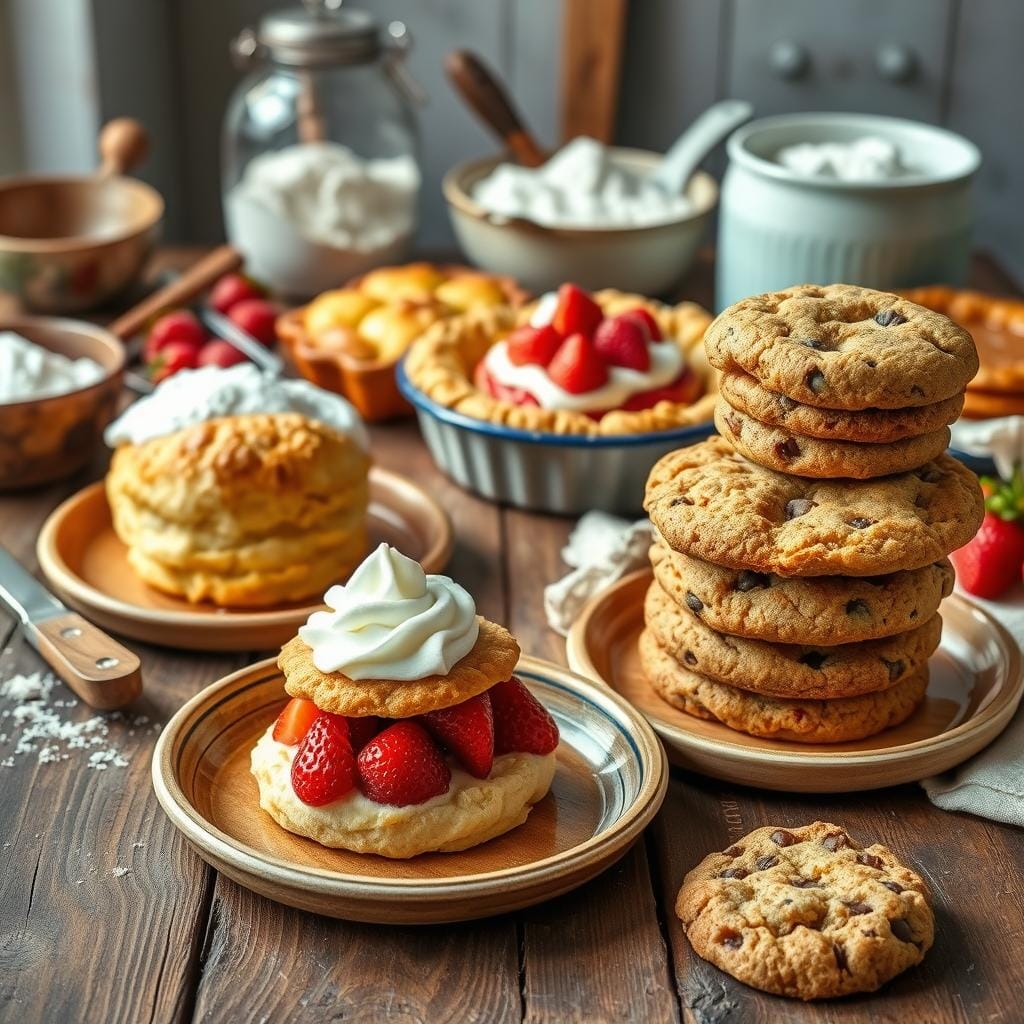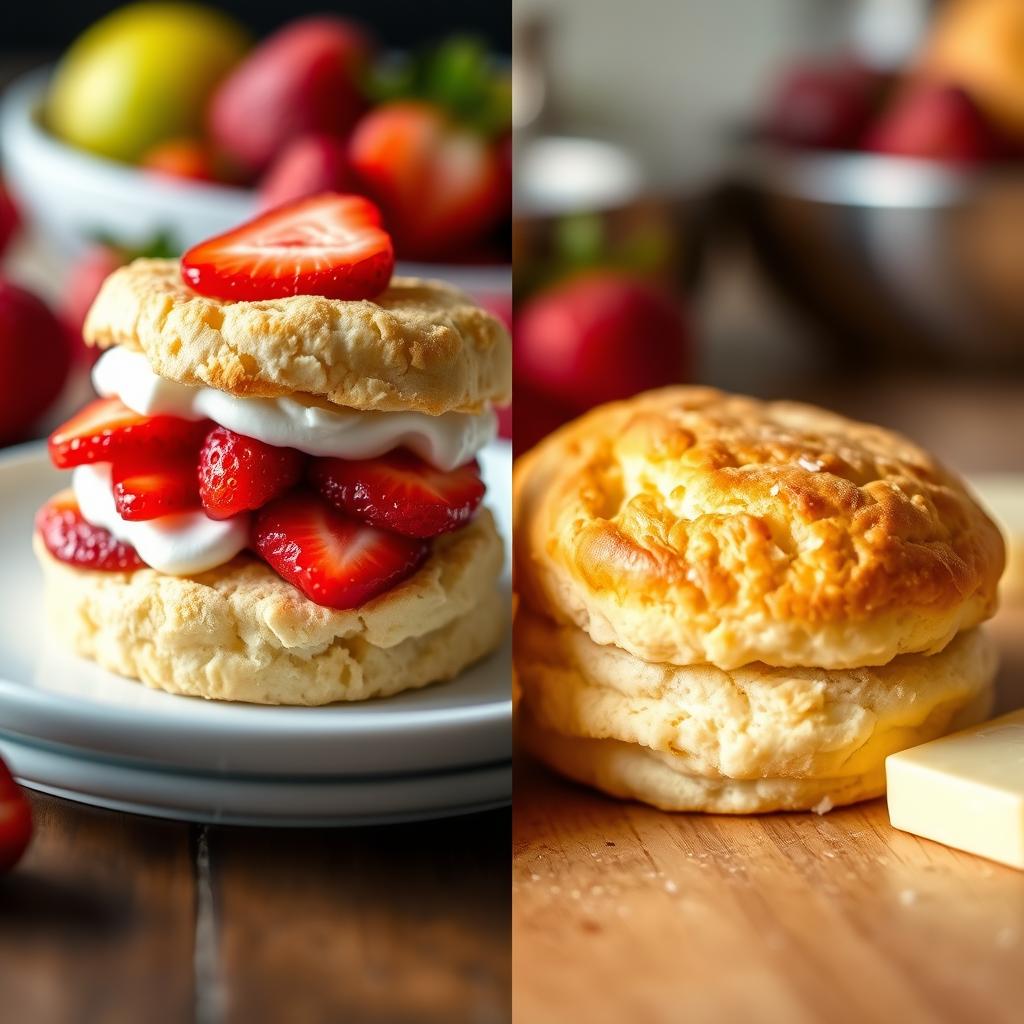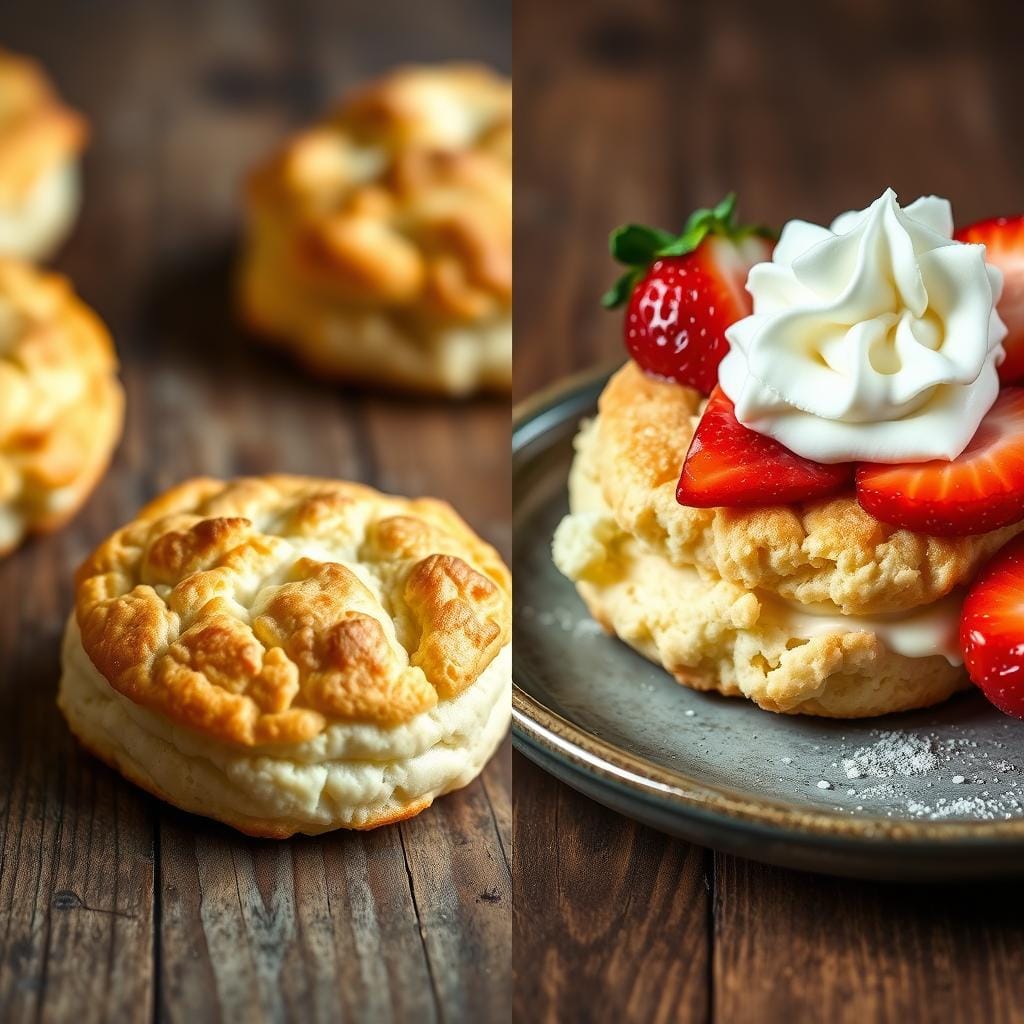Ever wondered about the real difference between shortcake and biscuit? These classic American baked goods may look similar at first. But, their origins, ingredients, and uses tell a fascinating story. As you explore these beloved pastries, you’ll find out what makes them unique.
Are shortcakes and biscuits the same, or do they have their own special place in American cuisine? This article will dive into their rich history, key ingredients, and how they’re made. You’ll gain a deeper understanding of their roles in our culinary heritage.

Key Takeaways
- Shortcakes and biscuits have distinct origins and ingredients that set them apart.
- Texture and structure are key differences between these classic baked goods.
- Regional variations across the United States have contributed to the evolution of both shortcakes and biscuits.
- Understanding the science behind their preparation methods can help you achieve the perfect texture.
- Serving suggestions and popular pairings showcase the versatility of these beloved treats.
Introduction to Classic American Baked Goods
America’s baking heritage is filled with rich traditions. Each tradition tells a unique story in our culinary culture. From the buttery scones and delicate tea cakes in the South to the beloved quick breads in American desserts, these treats are key parts of our identity.
The Heritage of Southern Baking
The South is known for its amazing baking. Generations of cooks and chefs have perfected their skills. The area’s rich land and tradition of welcoming guests have created a baking legacy that still charms us today.
Evolution of Quick Breads in American Cuisine
Quick breads like biscuits, cornbread, and muffins are a favorite in America. They offer a simple yet satisfying way to enjoy homemade baked goods. These quick breads have grown from simple beginnings, adapting to the country’s changing tastes and regional flavors.
| Classic American Baked Goods | Key Characteristics |
|---|---|
| Scones | Flaky, lightly sweetened biscuit-like pastries, often served with clotted cream and jam. |
| Tea Cakes | Delicate, crumbly cakes traditionally enjoyed with afternoon tea, sometimes flavored with citrus or spices. |
| Quick Breads | Leavened breads that can be prepared quickly without the need for lengthy kneading or rising times. |

“The aroma of freshly baked scones, tea cakes, and quick breads is like a siren call, luring us into the warm embrace of American baking traditions.”
Is shortcake the same as a biscuit?
While shortcake and buttermilk biscuits look similar, they are not the same. They differ in texture and sweetness.
Shortcake is a crumbly, sweet biscuit used in strawberry shortcake. It’s softer and sweeter than buttermilk biscuits. Shortcakes have more sugar and fat, making them richer.
Buttermilk biscuits, on the other hand, are light and savory. They use tangy buttermilk for a fluffy texture. They don’t have the sweetness of shortcakes.
“Shortcake is a unique biscuit-like treat that stands apart from the classic buttermilk biscuit. Its crumbly, sweet nature makes it the perfect base for sweet toppings and fruit-forward desserts.”
Even though both baked goods are made similarly, their ingredients and textures are different. This makes each a special part of American baking.

Basic Ingredients: Comparing Shortcake and Biscuit Recipes
In American cuisine, shortcakes and biscuits are two favorites. They share similarities but differ in ingredients. These differences affect their texture and taste.
Essential Shortcake Components
Shortcakes start with flour, sugar, baking powder, salt, and buttermilk. The key is the butter or shortening. It’s mixed into the dry ingredients, making the shortcake tender and crumbly.
Traditional Biscuit Ingredients
- All-purpose flour
- Baking powder
- Salt
- Cold butter or lard
- Buttermilk
The Role of Fats and Leavening Agents
Shortcakes and biscuits use fats and leavening agents in special ways. Biscuits get their flakiness from how the fat is mixed into the dough. This makes them light and airy.
Shortcakes, on the other hand, have a denser crumb. This is because they use more fat. This makes the dough stick together better.
| Ingredient | Shortcake | Biscuit |
|---|---|---|
| Fat | Butter or shortening | Butter, lard, or shortening |
| Leavening | Baking powder | Baking powder, sometimes baking soda |
“The secret to perfect baked goods lies in the precise balance of fats and leavening agents.”
Texture and Structure: Key Differences
When it comes to scones, tea cakes, and other desserts, texture and structure matter a lot. Shortcakes and biscuits differ mainly in their crumb, density, and how they feel in your mouth.
Shortcakes are soft and slightly crumbly. They are lighter and more delicate than biscuits. This is because they have more fat and sugar, making them tender and easy to break.
Biscuits, on the other hand, are flaky and dense. They have a layered texture that makes them satisfying to bite into. This flakiness comes from folding and layering the dough, which traps air and creates layers.
“The texture of a shortcake is a delicate balance, while a biscuit’s structure is all about achieving that perfect flakiness.”
These differences affect how we use them in cooking. Shortcakes are great for desserts with fruit because their crumb can absorb juices without getting soggy. Biscuits, however, are perfect for savory dishes like stews or as a base for sausage and gravy.
Knowing the unique textures of shortcakes and biscuits helps us enjoy these American baked goods more. Whether it’s a strawberry shortcake or a buttery biscuit, the feel in your mouth makes the experience better.
The Science Behind Their Preparation Methods
Making the perfect baked goods, like shortcakes and biscuits, is a mix of science and skill. It’s all about controlling temperature and mixing techniques. Knowing these secrets can change the texture and taste of your treats.
Temperature Control Techniques
How you handle ingredients, mix the dough, and bake it matters a lot. Keeping butter and fats cold makes them firm. This creates a flaky, tender texture. Also, chilling the dough before baking relaxes the gluten, making it even softer.
Getting the temperature right is key for baked goods that are soft and melt in your mouth.
Mixing Methods and Their Impact
- Gentle Mixing: A light touch when combining the dough ingredients prevents developing too much gluten, resulting in a more tender and delicate texture.
- Layering Techniques: Folding and rolling the dough creates distinct layers, trapping air pockets that expand during baking for a flakier, rise-filled biscuit or shortcake.
- Overworking Caution: Excessive mixing can lead to a tough, dense crumb, so it’s important to find the right balance for your recipe.
Learning the science behind these methods can help you make baked goods that look great and taste amazing. Try out different techniques to find the best way to make your favorite baked goods and quick breads.
Sweet vs Savory: Understanding Their Uses
Shortcakes and biscuits are incredibly versatile. They can easily switch between sweet and savory dishes. Strawberry shortcake is a beloved American dessert. But buttermilk biscuit can also be used in savory dishes.
These baked goods have qualities that fit different recipes. Shortcakes are tender and slightly sweet. They go well with fresh fruit and whipped cream. This mix of flavors is delightful.
Biscuits, on the other hand, are flaky and neutral-tasting. They’re great for sausage gravy, cheese, or as a base for savory sandwiches. This shows how versatile they are.
These baked goods are not just for sweet or savory dishes. Shortcakes can become shortbread-like cookies. Biscuits can be used in breakfast dishes or as a side to stews and roasted meats. The options are endless, making them key in American cuisine.
“Shortcakes and biscuits are the unsung heroes of the American kitchen, seamlessly transitioning between sweet and savory realms.”
Regional Variations Across the United States
While biscuits and shortcakes share a common heritage as beloved American pastries, their regional variations showcase the diverse culinary traditions that have shaped these quick breads across the country.
Southern Biscuit Traditions
In the Southern region, biscuits are a staple, deeply rooted in the area’s rich culinary history. They are known for their flaky, tender texture and are often served with savory toppings like sausage gravy. Southern biscuits are a symbol of comfort food and family gatherings.
The influence of African-American bakers has been key in shaping the unique flavors and preparation methods of Southern biscuits.
Northeastern Shortcake Preferences
In the Northeastern states, the preference is for tea cakes known as shortcakes. These sweet, dense pastries are often served with fresh seasonal berries and whipped cream. This combination creates a delightful balance of flavors that is a hallmark of summertime desserts in this region.
The Northeastern shortcake tradition has evolved over time, incorporating regional variations and innovative flavor combinations.
| Southern Biscuits | Northeastern Shortcakes |
|---|---|
| Characterized by flaky, tender texture | Sweet, dense pastries often served with berries and cream |
| Savory toppings like sausage gravy | Balanced flavors of sweet and fresh seasonal ingredients |
| Influenced by African-American baking traditions | Evolved over time with regional variations and innovations |
“The biscuit is a true testament to the melting pot of American cuisine, reflecting the diverse culinary influences that have shaped regional food traditions across the country.”
Serving Suggestions and Popular Pairings
Enjoying strawberry shortcake or buttermilk biscuits is even better with the right presentation. These desserts are perfect for creative serving ideas that will excite your taste buds.
For a classic strawberry shortcake treat, serve the biscuits or cake with fresh strawberries. Add a dollop of whipped cream or vanilla ice cream. This mix of sweet berries, light biscuit, and creamy topping is loved by all.
Want to spice up your buttermilk biscuits? Try them with savory toppings like bacon, mushrooms, or a fried egg. The buttery biscuit is a great base for these tasty combinations.
- Pair strawberry shortcake with a dollop of freshly whipped cream or a scoop of vanilla ice cream.
- Top buttermilk biscuits with savory ingredients like crumbled bacon, sautéed mushrooms, or a fried egg.
- Serve shortcake or biscuits with a selection of fresh, seasonal fruits for a refreshing and balanced dessert.
- Experiment with different jams, preserves, or honey to drizzle over your baked treats for an added touch of sweetness.
How you serve these American baked goods matters. The goal is to highlight their unique flavors and textures.
Common Mistakes in Making Both Treats
Making shortcakes and biscuits seems easy, but even pros can make mistakes. Issues like texture problems and temperature control errors are common. Knowing these mistakes helps you make perfect baked goods, pastries, and quick breads.
Troubleshooting Texture Issues
Getting the right texture is a big challenge. Overworking dough makes treats tough, while under-mixing makes them crumbly. It’s important to mix carefully and handle the dough gently.
Temperature Control Mistakes
- Failing to preheat the oven can cause uneven baking and soggy bottoms.
- Opening the oven door too often messes with the temperature, making treats fall flat.
- Letting dough sit too long before baking can make it collapse.
Being precise with temperature is key for a skilled baker. Getting this right ensures your treats come out perfectly every time.
“Baking is a science, and understanding the role of temperature is crucial to creating consistently excellent pastries and quick breads.”
With attention to detail and a bit of experimentation, you can improve your baked goods. This will take them to a whole new level of deliciousness.
Storage Tips and Shelf Life
Storing your homemade baked goods, pastries, and desserts right is key. It keeps them fresh and tasty. Whether it’s flaky biscuits or a tall shortcake, these tips will help. They ensure you get to enjoy every delicious bite.
Biscuit Storage
Biscuits are best eaten within 2-3 days. Cool them down, then put them in an airtight container. Don’t refrigerate them. The cold air can make them stale and lose their softness.
Shortcake Storage
Shortcakes can last up to 5 days if sealed well. Wrap each cooled cake in plastic wrap or use an airtight container. For the best taste, assemble with fruit or cream just before eating.
Freezing for Later
- You can freeze both biscuits and shortcakes for longer. Cool them down first, then wrap them in plastic or freezer bags.
- Biscuits can stay frozen for 3 months, and shortcakes for 6 months.
- To thaw, let them sit at room temperature or in the fridge. Then, warm them in a 350°F oven for 5-10 minutes to get that fresh-baked feel.
“Proper storage is key to keeping your pastries and desserts at their best. Follow these tips, and you’ll be enjoying flaky, tender biscuits and mouthwatering shortcakes for days to come.”
Modern Adaptations and Variations
Shortcake and biscuits have changed over time. Modern bakers are now making scones and tea cakes. They offer a wide range of flavors and options for everyone.
Artisanal bakers are trying new things. They add citrus zests, spices, and herbs to their recipes. Now, you can find shortcake with fruits, nuts, or even cheese and herbs.
Biscuits have also changed. They now come in flavors like cheddar and chive, or rosemary and parmesan. This shows how versatile biscuits can be.
Today, bakers are also using new ways to make these treats. They make gluten-free and vegan versions. They use whole grains, natural sweeteners, and organic produce. This makes these classic treats healthier but still delicious.

